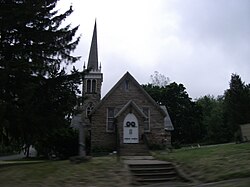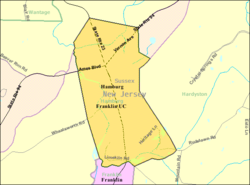Hamburg, New Jersey
| Hamburg, New Jersey | |
|---|---|
| Borough | |
| Borough of Hamburg | |

A church in Hamburg, New Jersey
|
|
 Map of Hamburg in Sussex County. Inset: Location of Sussex County in New Jersey. |
|
 Census Bureau map of Hamburg, New Jersey. |
|
| Coordinates: 41°08′54″N 74°34′24″W / 41.148442°N 74.573466°WCoordinates: 41°08′54″N 74°34′24″W / 41.148442°N 74.573466°W | |
| Country |
|
| State |
|
| County | Sussex |
| Incorporated | April 24, 1920 |
| Named for | Hamburg, Germany |
| Government | |
| • Type | Borough |
| • Body | Borough Council |
| • Mayor | Paul Marino (R, term ends December 31, 2018) |
| • Clerk | Dorren Schott |
| Area | |
| • Total | 1.165 sq mi (3.016 km2) |
| • Land | 1.142 sq mi (2.957 km2) |
| • Water | 0.023 sq mi (0.059 km2) 1.96% |
| Area rank | 489th of 566 in state 22nd of 24 in county |
| Elevation | 538 ft (164 m) |
| Population (2010 Census) | |
| • Total | 3,277 |
| • Estimate (2015) | 3,155 |
| • Rank | 441st of 566 in state 17th of 24 in county |
| • Density | 2,870.4/sq mi (1,108.3/km2) |
| • Density rank | 222nd of 566 in state 2nd of 24 in county |
| Time zone | Eastern (EST) (UTC-5) |
| • Summer (DST) | Eastern (EDT) (UTC-4) |
| ZIP code | 07419 |
| Area code(s) | 973 |
| FIPS code | 3403729220 |
| GNIS feature ID | 885241 |
| Website | www |
Hamburg is a borough in Sussex County, New Jersey, United States. As of the 2010 United States Census, the borough's population was 3,277, reflecting an increase of 172 (+5.5%) from the 3,105 counted in the 2000 Census, which had in turn increased by 539 (+21.0%) from the 2,566 counted in the 1990 Census.
In 1753, when Sussex County was formed, the area of present-day Hamburg was part of New Town; on February 25, 1762, it became part of the newly established Hardyston Township. On April 8, 1793, when Vernon Township was formed from Hardyston, Hamburg was included within the boundaries of Vernon. In 1852, the boundary line was changed so that Hamburg was again in Hardyston Township. Hamburg was incorporated as a borough on March 19, 1920, from portions of Hardyston Township, based on the results of a referendum held on April 24, 1920. The borough was named for Hamburg, Germany.
According to the United States Census Bureau, the borough had a total area of 1.165 square miles (3.016 km2), including 1.142 square miles (2.957 km2) of land and 0.023 square miles (0.059 km2) of water (1.96%).
The 2010 United States Census counted 3,277 people, 1,364 households, and 883.9 families residing in the borough. The population density was 2,870.4 per square mile (1,108.3/km2). The borough contained 1,476 housing units at an average density of 1,292.9 per square mile (499.2/km2). The racial makeup of the borough was 91.27% (2,991) White, 2.01% (66) Black or African American, 0.24% (8) Native American, 2.04% (67) Asian, 0.00% (0) Pacific Islander, 1.80% (59) from other races, and 2.62% (86) from two or more races. Hispanics or Latinos of any race were 6.87% (225) of the population.
...
Wikipedia
